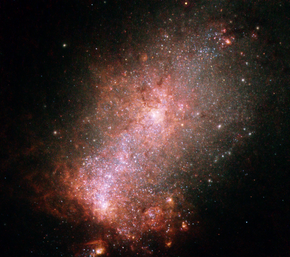| NGC 3125 | |
|---|---|
 | |
| Observation data (J2000 epoch) | |
| Constellation | Antlia |
| Right ascension | 10h 06m 33s |
| Declination | -29° 56’ 05” |
| Redshift | 0.003712 ± 0.000023 [1] |
| Heliocentric radial velocity | 1113 ± 7 km/s [1] |
| Apparent magnitude (B) | 13.45 |
| Surface brightness | 22.63 mag/arcsec2 |
| Characteristics | |
| Type | S;BCDG [1] |
| Apparent size (V) | 1.1′ × 0.7′ |
| Other designations | |
| ESO 435-G041, AM 1004-294, MCG -05-24-022 | |
NGC 3125 is an irregular dwarf starburst galaxy in the constellation Antlia that was discovered by John Herschel in 1835. [2] [3] It is located approximately 38 million light-years away from Earth. [4] [5] Starburst galaxies are galaxies in which unusually high numbers of new stars are forming, springing to life within intensely hot clouds of gas. [6]